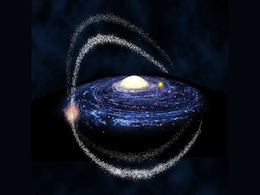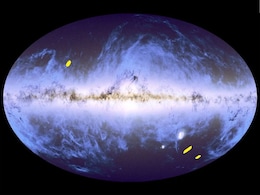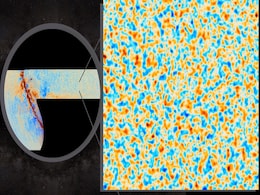Dark Matter
- All
- News
- Videos
- Web Stories
-

Astronomers Discover Potential ‘Dark Galaxy’ Near the Milky Way
- Monday April 21, 2025
- Written by Gadgets 360 Staff
Astronomers have spotted a massive hydrogen cloud near the Milky Way that may be a rare dark galaxy—an object composed of gas and dark matter but lacking stars and light. Detected through radio telescopes, the galaxy-like structure challenges conventional astronomy and could reveal hidden phases of galaxy formation and dark matter interaction in ...
-
 www.gadgets360.com
www.gadgets360.com
-

Dark Energy May Not Be Constant - How This Discovery Can Change Science
- Friday April 4, 2025
- World News | The Conversation
The great Russian physicist and Nobel laureate Lev Landau once remarked that "cosmologists are often in error, but never in doubt". In studying the history of the universe itself, there is always a chance that we have got it all wrong.
-
 www.ndtv.com
www.ndtv.com
-

James Webb Space Telescope Reveals a Stunning Einstein Ring in Hydrus
- Wednesday April 2, 2025
- NDTV
A striking new image from the James Webb Space Telescope reveals an Einstein ring in the Hydrus constellation. The phenomenon occurs when a massive foreground galaxy bends light from a hidden background galaxy, forming a near-perfect ring. This effect, predicted by Einstein’s theory of general relativity, helps astronomers study galaxies from the...
-
 www.gadgets360.com
www.gadgets360.com
-

Did Black Hole Radiation Shape the Universe?
- Saturday March 29, 2025
- Written by Gadgets 360 Staff
A study suggests that Hawking radiation, first proposed by Stephen Hawking, may have influenced the universe’s structure. According to reports, primordial black holes that existed in the early universe could have evaporated through Hawking radiation, impacting matter distribution. The research explores how these black holes might have shaped gala...
-
 www.gadgets360.com
www.gadgets360.com
-

ESA’s Euclid Telescope Releases First Data, Mapping 26 Million Galaxies
- Wednesday March 26, 2025
- Written by Gadgets 360 Staff
ESA’s Euclid telescope has released its first dataset, mapping 26 million galaxies within a week. The observations include deep-field images, a survey of 380,000 galaxies, and 500 new gravitational lens candidates. Scientists will continue tracking cosmic evolution over six years. The dataset, currently 35 terabytes, is expected to grow to 2 peta...
-
 www.gadgets360.com
www.gadgets360.com
-

What Is Dark Energy? The Mystery Behind The Expanding Universe
- Thursday March 20, 2025
- World News | Agence France-Presse
Dark energy makes up roughly 70 percent of the universe, yet we know nothing about it. Around 25 percent of the universe is the equally mysterious dark matter, leaving just five percent for everything that we can see and touch.
-
 www.ndtv.com
www.ndtv.com
-

Atacama Telescope Reveals Most Detailed Cosmic Microwave Background Yet
- Thursday March 20, 2025
- Written by Gadgets 360 Staff
New images from the decommissioned Atacama Cosmology Telescope offer the most detailed view of the cosmic microwave background. The data reveals early cosmic structures, tracks primordial gas movement, and refines estimates of the universe’s total mass. While supporting existing models, it does not resolve the Hubble tension. Researchers are now ...
-
 www.gadgets360.com
www.gadgets360.com
-

Energy Signals From Milky Way's Core Could Unveil New Type Of Dark Matter: Study
- Friday March 14, 2025
- Science | Edited by Nikhil Pandey
A new study suggests that clues about dark matter may be hidden in the Milky Way's Central Molecular Zone, where unexplained chemical reactions could be caused by a lighter form of dark matter.
-
 www.ndtv.com
www.ndtv.com
-

New Dark Matter Hypothesis Suggests Ionisation Clue in Milky Way’s Core
- Wednesday March 12, 2025
- Written by Gadgets 360 Staff
Researchers propose that an overlooked dark matter candidate may explain unusual ionisation levels in the Milky Way’s Central Molecular Zone (CMZ). This theory suggests that lightweight, self-annihilating dark matter particles could be producing electrons and positrons, influencing cosmic chemistry. The findings challenge conventional views, offe...
-
 www.gadgets360.com
www.gadgets360.com
-

Unexpected Rotational Motion Detected in Ultra-Diffuse Galaxies of Hydra Cluster
- Wednesday March 5, 2025
- Written by Gadgets 360 Staff
Astronomers studying ultra-diffuse galaxies (UDGs) in the Hydra cluster have observed unexpected rotational movement in nearly half of the 30 galaxies examined. Spectroscopic data from the LEWIS programme, using the MUSE instrument on the Very Large Telescope, suggests that gravitational interactions with larger galaxies may influence their formati...
-
 www.gadgets360.com
www.gadgets360.com
-

New Study Reveals How Pulsars Help Measure Dark Matter in the Milky Way
- Tuesday March 4, 2025
- Written by Gadgets 360 Staff
A breakthrough study has used pulsar acceleration data to measure dark matter density in the Milky Way. Previously, binary pulsars were the primary source of data, but now solitary pulsars have been included, doubling the dataset. The research also provides evidence of the Milky Way’s "wobble" due to interactions with dwarf galaxies. By mapping t...
-
 www.gadgets360.com
www.gadgets360.com
-

Black Hole Hunter Priyamvada Natarajan Searches For The Unseen Universe
- Monday February 24, 2025
- Science | Reported by Pallava Bagla, Edited by Aastha Ahuja
Black holes are a place in the universe where gravity is so intense that not even light can escape.
-
 www.ndtv.com
www.ndtv.com
-

What Happens if You're Struck By A Tiny Black Hole? Study Reveals Shocking Details
- Tuesday February 18, 2025
- Science | Edited by Nikhil Pandey
A recent study explores the effects of tiny black holes on the human body, finding that while tidal forces would cause local damage, shock waves could be deadly, but the likelihood of being struck is incredibly low.
-
 www.ndtv.com
www.ndtv.com
-

Frontier Supercomputer Simulates Universe with Unmatched Complexity
- Tuesday February 18, 2025
- Written by Gadgets 360 Staff
The Frontier supercomputer at Oak Ridge National Laboratory has conducted the most detailed universe simulation to date. Using the Hardware/Hybrid Accelerated Cosmology Code (HACC) under the U.S. Department of Energy’s Exascale Computing Project, the model incorporates dark matter, gas, and plasma interactions. With speeds reaching 1.4 exaFLOPS, ...
-
 www.gadgets360.com
www.gadgets360.com
-

Astronomers Discover Potential ‘Dark Galaxy’ Near the Milky Way
- Monday April 21, 2025
- Written by Gadgets 360 Staff
Astronomers have spotted a massive hydrogen cloud near the Milky Way that may be a rare dark galaxy—an object composed of gas and dark matter but lacking stars and light. Detected through radio telescopes, the galaxy-like structure challenges conventional astronomy and could reveal hidden phases of galaxy formation and dark matter interaction in ...
-
 www.gadgets360.com
www.gadgets360.com
-

Dark Energy May Not Be Constant - How This Discovery Can Change Science
- Friday April 4, 2025
- World News | The Conversation
The great Russian physicist and Nobel laureate Lev Landau once remarked that "cosmologists are often in error, but never in doubt". In studying the history of the universe itself, there is always a chance that we have got it all wrong.
-
 www.ndtv.com
www.ndtv.com
-

James Webb Space Telescope Reveals a Stunning Einstein Ring in Hydrus
- Wednesday April 2, 2025
- NDTV
A striking new image from the James Webb Space Telescope reveals an Einstein ring in the Hydrus constellation. The phenomenon occurs when a massive foreground galaxy bends light from a hidden background galaxy, forming a near-perfect ring. This effect, predicted by Einstein’s theory of general relativity, helps astronomers study galaxies from the...
-
 www.gadgets360.com
www.gadgets360.com
-

Did Black Hole Radiation Shape the Universe?
- Saturday March 29, 2025
- Written by Gadgets 360 Staff
A study suggests that Hawking radiation, first proposed by Stephen Hawking, may have influenced the universe’s structure. According to reports, primordial black holes that existed in the early universe could have evaporated through Hawking radiation, impacting matter distribution. The research explores how these black holes might have shaped gala...
-
 www.gadgets360.com
www.gadgets360.com
-

ESA’s Euclid Telescope Releases First Data, Mapping 26 Million Galaxies
- Wednesday March 26, 2025
- Written by Gadgets 360 Staff
ESA’s Euclid telescope has released its first dataset, mapping 26 million galaxies within a week. The observations include deep-field images, a survey of 380,000 galaxies, and 500 new gravitational lens candidates. Scientists will continue tracking cosmic evolution over six years. The dataset, currently 35 terabytes, is expected to grow to 2 peta...
-
 www.gadgets360.com
www.gadgets360.com
-

What Is Dark Energy? The Mystery Behind The Expanding Universe
- Thursday March 20, 2025
- World News | Agence France-Presse
Dark energy makes up roughly 70 percent of the universe, yet we know nothing about it. Around 25 percent of the universe is the equally mysterious dark matter, leaving just five percent for everything that we can see and touch.
-
 www.ndtv.com
www.ndtv.com
-

Atacama Telescope Reveals Most Detailed Cosmic Microwave Background Yet
- Thursday March 20, 2025
- Written by Gadgets 360 Staff
New images from the decommissioned Atacama Cosmology Telescope offer the most detailed view of the cosmic microwave background. The data reveals early cosmic structures, tracks primordial gas movement, and refines estimates of the universe’s total mass. While supporting existing models, it does not resolve the Hubble tension. Researchers are now ...
-
 www.gadgets360.com
www.gadgets360.com
-

Energy Signals From Milky Way's Core Could Unveil New Type Of Dark Matter: Study
- Friday March 14, 2025
- Science | Edited by Nikhil Pandey
A new study suggests that clues about dark matter may be hidden in the Milky Way's Central Molecular Zone, where unexplained chemical reactions could be caused by a lighter form of dark matter.
-
 www.ndtv.com
www.ndtv.com
-

New Dark Matter Hypothesis Suggests Ionisation Clue in Milky Way’s Core
- Wednesday March 12, 2025
- Written by Gadgets 360 Staff
Researchers propose that an overlooked dark matter candidate may explain unusual ionisation levels in the Milky Way’s Central Molecular Zone (CMZ). This theory suggests that lightweight, self-annihilating dark matter particles could be producing electrons and positrons, influencing cosmic chemistry. The findings challenge conventional views, offe...
-
 www.gadgets360.com
www.gadgets360.com
-

Unexpected Rotational Motion Detected in Ultra-Diffuse Galaxies of Hydra Cluster
- Wednesday March 5, 2025
- Written by Gadgets 360 Staff
Astronomers studying ultra-diffuse galaxies (UDGs) in the Hydra cluster have observed unexpected rotational movement in nearly half of the 30 galaxies examined. Spectroscopic data from the LEWIS programme, using the MUSE instrument on the Very Large Telescope, suggests that gravitational interactions with larger galaxies may influence their formati...
-
 www.gadgets360.com
www.gadgets360.com
-

New Study Reveals How Pulsars Help Measure Dark Matter in the Milky Way
- Tuesday March 4, 2025
- Written by Gadgets 360 Staff
A breakthrough study has used pulsar acceleration data to measure dark matter density in the Milky Way. Previously, binary pulsars were the primary source of data, but now solitary pulsars have been included, doubling the dataset. The research also provides evidence of the Milky Way’s "wobble" due to interactions with dwarf galaxies. By mapping t...
-
 www.gadgets360.com
www.gadgets360.com
-

Black Hole Hunter Priyamvada Natarajan Searches For The Unseen Universe
- Monday February 24, 2025
- Science | Reported by Pallava Bagla, Edited by Aastha Ahuja
Black holes are a place in the universe where gravity is so intense that not even light can escape.
-
 www.ndtv.com
www.ndtv.com
-

What Happens if You're Struck By A Tiny Black Hole? Study Reveals Shocking Details
- Tuesday February 18, 2025
- Science | Edited by Nikhil Pandey
A recent study explores the effects of tiny black holes on the human body, finding that while tidal forces would cause local damage, shock waves could be deadly, but the likelihood of being struck is incredibly low.
-
 www.ndtv.com
www.ndtv.com
-

Frontier Supercomputer Simulates Universe with Unmatched Complexity
- Tuesday February 18, 2025
- Written by Gadgets 360 Staff
The Frontier supercomputer at Oak Ridge National Laboratory has conducted the most detailed universe simulation to date. Using the Hardware/Hybrid Accelerated Cosmology Code (HACC) under the U.S. Department of Energy’s Exascale Computing Project, the model incorporates dark matter, gas, and plasma interactions. With speeds reaching 1.4 exaFLOPS, ...
-
 www.gadgets360.com
www.gadgets360.com

































